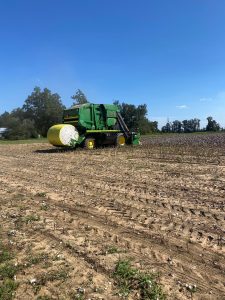If you’ve spent much time at all paying attention to what’s growing in Panhandle crop fields, you may have noticed a decrease in planted cotton acres. In normal years, the crop acreage in our area is split roughly evenly between cotton and peanuts, with soybean and corn grown in smaller quantities. However, world economic conditions have pushed cotton prices below the cost of production for American farmers and forced them into a tough decision this year – “Do I plant cotton and definitely lose money or branch out to a different crop and hope to make something?” So, what are the conditions causing persistently low cotton prices and how will it affect what we grow going forward?
As nebulous and complicated as world economic markets might seem, the price of all goods (cotton included) comes down to one basic idea – supply and demand. When supply is higher than demand, prices fall. Put simply, global supply of cotton has exceeded global demand for cotton, so price has followed demand down. This has occurred for two primary reasons. First, people aren’t wearing cotton like they used to. Most folks don’t often reach for a thick cotton shirt or cotton fabric pants when they get dressed. Rather, people have populated their wardrobes with the lightweight, breathable, sweat-wicking synthetic fibers found in leisure type clothes (and increasingly in casual and dressy clothes too). If cotton is worn at all, it’s now typically blended with these synthetic fibers. This sea change in fashion has meant much less demand for cotton.
Second, there is simply a huge amount of cotton being produced at the same time fashion trends have changed. While U.S. acres are down in response to price, other countries with lower costs of production continue to crank out vast acres of the fiber. Most troubling, according to USDA data, in the 2023-2024 crop year, Brazil surpassed the U.S. as the world’s largest cotton exporter. As ag technology, largely developed in the U.S., catches up in these developing countries, they become able to produce cotton, and many other crops, at a lower cost than we can, partially because of cheaper labor and much more relaxed regulatory environments.
So, what does “below cost of production” cotton mean for local farmers? This year, it has meant more acres planted in peanut and corn. Neither of these is likely a long-term fix though. Peanuts, the Panhandle’s most important row crop, require a rotation partner to help manage persistent soil diseases that can decimate yields if peanuts are grown in the same spot in too many subsequent seasons. This year, many growers planted peanuts in the same fields in back-to-back years, knowing that can be problematic if pushed too far. Agronomically, corn is a good rotation partner for peanut and many acres of it have been planted this year. However, corn is a very water intensive crop, especially during the critical grain fill period. Many Panhandle farmers largely rely on rainfall to water crops (peanut and cotton do fine in this system) but rainfed corn (especially in sandy soils) is very, very risky. Given how few irrigation pivots there are across the Panhandle, the risk of rainfed corn being decimated by a single multi-week drought, and the current not-so rosy price of corn, relying on corn to replace cotton is iffy long-term.
Low cotton prices have other consequences too. Most area farmers have recently upgraded to roller pickers to harvest their cotton lint. These machines, while hyper efficient and labor reducing, also now cost around $1 million apiece and interest on equipment loans must be paid, whether cotton is produced or not. Additionally, for the thousands of acres that cotton is planted, that crop still must be fertilized and protected with herbicides, insecticides, and fungicides. The costs of those inputs have only increased. How will these costs be managed when you know you won’t make your money back on the crop?
Only time will tell, but the future of cotton in the Panhandle and the U.S. is anything but rosy at this point. Having said that, farmers have navigated hard times before and will again. They’re resourceful and excellent at what they do. Solutions will be found. We can just hope that until that day comes, farmers will continue to find a way forward. In the interim, thank them for their work ensuring we have a safe and affordable supply of food, fiber, and shelter.
- Stay Ahead of Peanut Fungal Pathogens This Summer - August 8, 2025
- Panhandle Cotton Acres Are Down in 2025– Here’s the Reason - July 11, 2025
- It Snowed, But Has This Been a Historically Cold Winter? What the Data Says. - January 31, 2025

